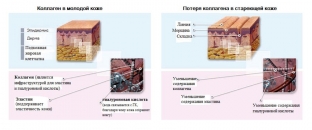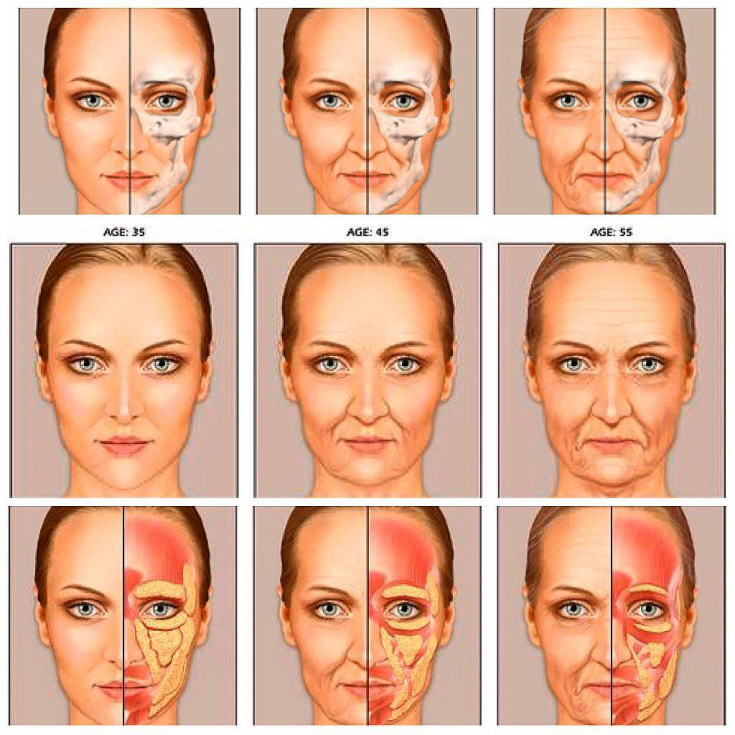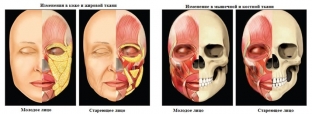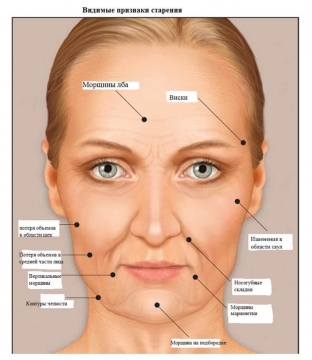How does a young face differ from an aging one? Wrinkles, deterioration of skin quality, sagging tissues, loss of volume – the main visible signs of age-related changes with which patients turn to cosmetologists and plastic surgeons. However, few people think that their appearance is associated with processes that affect deeper layers of the face than the skin – muscles, fat and even bone tissue.
Therefore, estet-portal.com in this article will talk about the anatomy of facial aging and the procedures that are used to restore youth on its different layers.
The Anatomy of Facial Aging: The Complementary Effect of Change
The aging process of the face begins with superficial and subsurface structural changes that affect several of its layers at once. At the same time, changes in tissues with age "complement" each other, increasing the severity of signs of aging: the lack of so-called youth proteins and moisture in the skin is aggravated by the loss of volume, the skin begins to sag, wrinkles appear on it, including mimic wrinkles, which are formed due to excessive muscle activity. Therefore, acting solely on the skin, it is impossible to make a face with pronounced signs of aging look young.
Changes in tissues with age "complement" each other, increasing the severity of signs of aging.
Therefore, we will look at the main points of the anatomy of facial aging at 4 levels:
- skin;
- muscles;
- fat;
- bones.
Skin: "visible section" anatomy of facial aging
Skin undergoes certain changes with age, which include:
- thinning;
- moisture loss;
- loss of elasticity;
- susceptibility to wrinkling and sagging;
- decrease in the amount of collagen.

Decrease in the amount of collagen in the skin – one of the key factors in the aging process. With age, the middle layer of the skin (dermis) becomes thinner due to the loss of this protein. The decrease in skin elasticity is the result of a decrease in elastin fibers, and a lack of moisture – a decrease in the content of hyaluronic acid. For this reason, the skin becomes:
- drier;
- less elastic;
- thinned.
Redistribution of fat on the face – important part of the anatomy of aging
The youthfulness of the face, in addition to the quality of the skin, depends on the amount and distribution of fat. The reasons for the loss of facial volumes are redistribution, accumulation and atrophy in this layer, namely:
- fat loss – e.g. forehead and cheeks;
- fat accumulation – e.g. in the area of the mouth and lower jaw;
- modification of fat pads leads to a violation of the contours of the face.

Furthermore, the redistribution of fat is also a factor that contributes to greater expression of the signs of aging. As a result, the fat packs, instead of forming a homogeneous layer, look like separate structures.
Anatomy of facial aging at muscle level
Age-related changes in muscle work are also reflected in the skin: since the musculoaponeurotic system "slips" under the influence of gravity, down, it also pulls the skin along with it, the quality of which is already deteriorating.
In addition, the mimic muscles are known to play a decisive role in the formation of mimic wrinkles, which can appear even at a fairly young age. This happens because:
- the tone of the levator muscles decreases, which raise one or another part of the face;
- the tone of the depressor muscles increases, which, accordingly, lowers parts of the face.
As a result of such changes, the face becomes sadder.
The subcutaneous muscle of the neck – also plays a significant role in the anatomy of facial aging. platysma.
Bone layer – the deepest part of the anatomy of facial agingAge-related changes also affect the craniofacial skeleton, which may be associated with the peculiarities of the dynamics of growth and resorption of bone tissue, which leads to the loss of biometric volume. Without structural bone support, changes in the soft tissues of the face are observed, resulting in:
- increase in the severity of bone structures, lines and wrinkles;
- more pronounced nasolabial folds;
- deepening forehead wrinkles;
- loss of volume and tissue ptosis in the middle part of the face;
- appearance or deepening of vertical mouth wrinkles, thinning and loss of lip volume;
- appearance of the premaxillary sulcus (marionette lines).

Age-related changes also affect the craniofacial skeleton, which may be associated with the peculiarities of the dynamics of growth and resorption of bone tissue, which leads to a loss of biometric volume.Anatomy of aging and a map of the face: how to restore the harmony of youth
As we age, facial proportions and symmetry change. For example:
- the lower part of the face becomes wider;
- lower face shortens as jaws remodel;
- the ratio between the distances from the upper lip to the nose and from the lower lip to the chin is 1/3:2/3; with age, this ratio is 1:1.
- symmetry of both parts of the face;
- smooth convex facial contours;
- Uniformity of skin tone and texture.
How to choose anti-aging procedures taking into account the anatomy of the face
When choosing procedures for facial rejuvenation, it is important to understand which anatomical levels are affected by the aging process, and choose effective anti-age techniques to eliminate them. So, for facial rejuvenation, three main categories of techniques are used:
- Skin Remodeling – techniques belonging to this category are used to change the surface of the skin. With their help, you can correct the effect of photoaging, including fine lines, uneven pigmentation and other skin imperfections. These include but are not limited to:
- chemical peels;
- microdermabrasion;
- laser rejuvenation.
- neurotoxins – botulinum toxin is used to relax muscles and minimize dynamic wrinkles; this substance is injected directly into the muscle; only wrinkles, the appearance of which is caused by muscle contraction, are smoothed in this way; most often, botulinum toxin is injected into the upper part of the face (to smooth forehead wrinkles, crow's feet, wrinkles between the eyebrows);
- traditional fillers – substances (liquids or gels) that are injected into the skin to smooth out wrinkles and lines, increase lips, replenish volume in the cheek area, replace lost fat; such preparations are introduced into the dermis or subcutaneous layer – it depends on the filler and the purpose of its introduction;
- collagen stimulators – since collagen synthesis slows down with aging, and its destruction accelerates, it is important to make up for the lack of this protein in the skin; collagen stimulators are introduced into the dermis or subcutaneous layer, mainly to stimulate the production of new fibers in the skin and then fill them with voids formed during the aging process; new collagen acts as a structural framework that holds hyaluronic acid and elastin and helps restore the dermis; hyaluronic acid attracts water molecules to the dermis and restores the normal level of skin moisture; elastin, respectively, increases the elasticity of the skin.

Fillers or Botox – which procedure is better to choose
- Surgical procedures that include many options – from lifts to liposuction and fat grafting to achieve a variety of goals. The most popular surgical methods for facial rejuvenation are:
- liposuction;
- facelift;
- fat grafting.






Add a comment